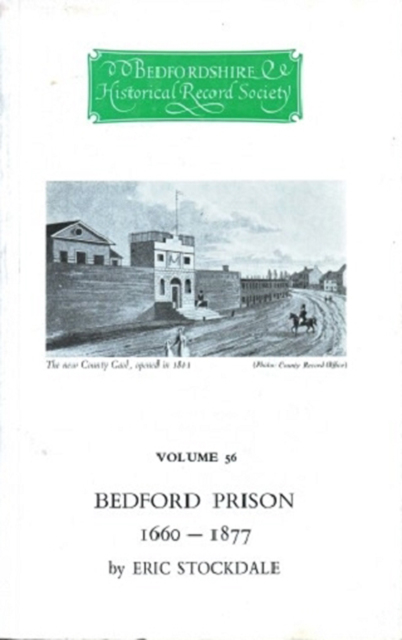Book contents
- Frontmatter
- Contents
- Acknowledgments
- Foreword
- Introduction
- Chapter 1 John Bunyan 1660-1688
- Chapter 2 Some Contemporaries of Bunyan
- Chapter 3 The Richardson-Howard Family of Jailers 1711-1814
- Chapter 4 Transportation to America Before 1776
- Chapter 5 John Howard 1773-1790
- Chapter 6 Samuel Whitbread 1790-1815
- Chapter 7 Philip Hunt 1815-1835
- Chapter 8 Philip Hunt 1815-1835
- Chapter 9 Lord John Russell In Office 1835-1841
- Chapter 10 The Rebuilding of The Jail 1839-1849
- Chapter 11 The Unsettled Years 1849-1853
- Chapter 12 The Final Years Before Nationalisation 1853-1877
- Conclusion
- Note On References and Spelling
- Appendix 1 Bedford in 1765
- Appendix 2 Jailers of Bedford 1710-1885
- Appendix 3 The Richardson-Howard Family
- Appendix 4 Site Plan of Bunyan’s Jail
- Appendix 5 Deed of Appointment of Jailers 1740
- Appendix 6 The Whitbread-Howard Link
- Appendix 7 Lord John Russell’s Family
- Appendix 8 Bedford in 1841
- Appendix 9 The Jail in 1849
- Index of Names
- Subject Index
- Bedfordshire Historical Record Society
- Miscellaneous Endmatter
Chapter 4 - Transportation to America Before 1776
Published online by Cambridge University Press: 03 August 2023
- Frontmatter
- Contents
- Acknowledgments
- Foreword
- Introduction
- Chapter 1 John Bunyan 1660-1688
- Chapter 2 Some Contemporaries of Bunyan
- Chapter 3 The Richardson-Howard Family of Jailers 1711-1814
- Chapter 4 Transportation to America Before 1776
- Chapter 5 John Howard 1773-1790
- Chapter 6 Samuel Whitbread 1790-1815
- Chapter 7 Philip Hunt 1815-1835
- Chapter 8 Philip Hunt 1815-1835
- Chapter 9 Lord John Russell In Office 1835-1841
- Chapter 10 The Rebuilding of The Jail 1839-1849
- Chapter 11 The Unsettled Years 1849-1853
- Chapter 12 The Final Years Before Nationalisation 1853-1877
- Conclusion
- Note On References and Spelling
- Appendix 1 Bedford in 1765
- Appendix 2 Jailers of Bedford 1710-1885
- Appendix 3 The Richardson-Howard Family
- Appendix 4 Site Plan of Bunyan’s Jail
- Appendix 5 Deed of Appointment of Jailers 1740
- Appendix 6 The Whitbread-Howard Link
- Appendix 7 Lord John Russell’s Family
- Appendix 8 Bedford in 1841
- Appendix 9 The Jail in 1849
- Index of Names
- Subject Index
- Bedfordshire Historical Record Society
- Miscellaneous Endmatter
Summary
The Transportation System
We have already seen that some of Bunyan’s companions were pardoned on condition that they were transported, and also that some had their departure delayed or put off altogether. A. E. Smith has said of the early years of transportation: ‘Various testimonies indicate that in fact the procedure did not work very well; that great numbers of convicts were never transported at all; that the sheriffs and especially the jailers were careless in their duties, and more interested in receiving fees than in attending to the safe departure of their charges’.
In 1664 some of the judges ordered, ‘that such prisoners as are reprieved with intent to be transported be not sent away as perpetual slaves, but upon indentures’. One of those judges was Sir John Kelyng, Bunyan’s judge, and it is from his series of law reports that we know of this ruling. Soon after this both Virginia and Maryland, which had been accepting transported prisoners, prohibited their entry, so that only the West Indies were used for a while. Despite this restriction, during the last twenty years of the seventeenth century some 4,500 convicts were sent to various colonies from England.
The eighteenth century brought with it a rapid expansion of the transportation system. The increased availability of the plea of clergy led to a large number of felons receiving the relatively mild punishment of branding plus one year’s imprisonment. Parliament responded by providing transportation as an alternative penalty for the less serious offences which remained clergyable. Some felonies continued non-clergyable, and so the death penalty was still passed for convictions of such offences, but increasingly this penalty was commuted on condition that the offender was transported. In short, an increasing number of prisoners were transported in the eighteenth century: either because of an original sentence of transportation, or because of a commuted death sentence.
- Type
- Chapter
- Information
- Bedford Prison 1660-1877 , pp. 53 - 65Publisher: Boydell & BrewerFirst published in: 2023



